
The Republic of China Armed Forces (ROCAF) are the armed forces of Taiwan (ROC), once based in mainland China and currently in its remaining jurisdictions which include the islands of Taiwan, Penghu, Kinmen, Matsu, and other smaller ROC-controlled islands such as Taiping Island in the South China Sea.
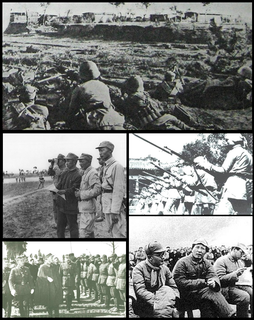
The Chinese Civil War was fought between the Kuomintang-led government of the Republic of China and forces of the Chinese Communist Party, lasting intermittently after 1927.
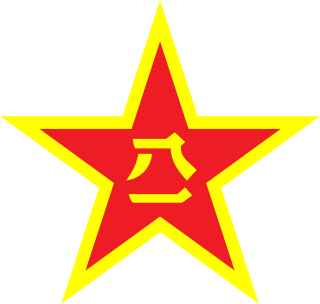
The People's Liberation Army (PLA) is the principal military force of the People's Republic of China and the armed wing of the Chinese Communist Party (CCP). The PLA consists of five service branches: the Ground Force, Navy, Air Force, Rocket Force, and Strategic Support Force. It is under the leadership of the Central Military Commission (CMC) with its chairman as commander-in-chief.
Sino-Japanese War most often refers to:
The history of the Republic of China begins after the Qing dynasty in 1912, when the Xinhai Revolution and the formation of the Republic of China put an end to 2,000 years of imperial rule. The Republic experienced many trials and tribulations after its founding which included being dominated by elements as disparate as warlord generals and foreign powers.
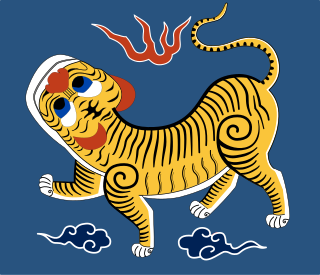
The Republic of Formosa was a short-lived republic that existed on the island of Taiwan in 1895 between the formal cession of Taiwan by the Qing dynasty of China to the Empire of Japan by the Treaty of Shimonoseki and its being taken over by Japanese troops. The Republic was proclaimed on 23 May 1895 and extinguished on 21 October, when the Republican capital Tainan was taken over by the Japanese. Though sometimes claimed as the first Asian republic to have been proclaimed, it was predated by the Lanfang Republic in Borneo, established in 1777, as well as by the Republic of Ezo in Japan, established in 1869.
Military of China may refer to:
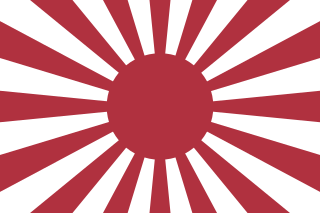
The Imperial Japanese Army was the official ground-based armed force of the Empire of Japan from 1868 to 1945. It was controlled by the Imperial Japanese Army General Staff Office and the Ministry of the Army, both of which were nominally subordinate to the Emperor of Japan as supreme commander of the army and the Imperial Japanese Navy. Later an Inspectorate General of Aviation became the third agency with oversight of the army. During wartime or national emergencies, the nominal command functions of the emperor would be centralized in an Imperial General Headquarters (IGHQ), an ad hoc body consisting of the chief and vice chief of the Army General Staff, the Minister of the Army, the chief and vice chief of the Naval General Staff, the Inspector General of Aviation, and the Inspector General of Military Training.

The Second Taiwan Strait Crisis, also called the 1958 Taiwan Strait Crisis, was a conflict that took place between the People's Republic of China (PRC) and the Republic of China (ROC). In this conflict, the PRC shelled the islands of Kinmen (Quemoy) and the Matsu Islands along the east coast of mainland China to "liberate" Taiwan from the Chinese Nationalist Party, also known as the Kuomintang (KMT); and to probe the extent of the United States defense of Taiwan's territory. A naval battle also took place around Dongding Island when the ROC Navy repelled an attempted amphibious landing by the PRC Navy.

A military hospital is a hospital owned and operated by the armed forces. They are often reserved for the use of military personnel and their dependents, but in some countries are made available to civilians as well. They may or may not be located on a military base; many are not.

The Taiwan Garrison Command was a secret police/national security body which existed under the Republic of China Armed Forces on Taiwan. The agency was established at the end of World War II, and operated throughout the Cold War. It was disbanded on 1 August 1992.

The China Garrison Army was formed 1 June 1901 as the Chinese Empire Garrison Army, as part of Japan's contribution to the international coalition in China during the Boxer Rebellion. It took the name China Garrison Army from 14 April 1912 and onward, though was typically referred to as the Tianjin Garrison.

In the People's Republic of China, theater commands are joint commands responsible for developing strategy, plans, tactics, and policy specific to their assigned area of responsibility. Currently, the PRC subdivides the nation into five theater commands, Eastern, Southern, Western, Northern, and Central to provide the Central Military Commission (CMC) of the Chinese Communist Party (CCP) extensive, though not exclusive, command authority over the assigned region.

The Japanese invasion of Taiwan was a conflict between the Empire of Japan and the armed forces of the short-lived Republic of Formosa following the Qing dynasty's cession of Taiwan to Japan in April 1895 at the end of the First Sino-Japanese War. The Japanese sought to take control of their new possession, while the Republican forces fought to resist Japanese occupation. The Japanese landed near Keelung on the northern coast of Taiwan on 29 May 1895, and in a five-month campaign swept southwards to Tainan. Although their advance was slowed by guerrilla activity, the Japanese defeated the Formosan forces whenever they attempted to make a stand. The Japanese victory at Baguashan on 27 August, the largest battle ever fought on Taiwanese soil, doomed the Formosan resistance to an early defeat. The fall of Tainan on 21 October ended organised resistance to Japanese occupation, and inaugurated five decades of Japanese rule in Taiwan.

Rikichi Andō was a general in the Imperial Japanese Army and 19th and final Japanese Governor-General of Taiwan from 30 December 1944 to October 1945.
Law enforcement in Taiwan operates primarily through governmental police agencies.
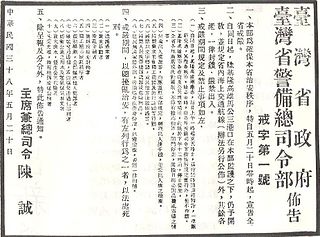
Martial law in Taiwan refers to the periods in the history of Taiwan after World War II during control by the Republic of China Armed Forces of the Kuomintang-led Government of the Republic of China regime. The term is specifically used to refer to the over 38-year-long consecutive martial law period between 20 May 1949 and 14 July 1987, which was qualified as "the longest imposition of martial law by a regime anywhere in the world" at that time.

The Taiwan Army of Japan was an army of the Imperial Japanese Army recruited from, and stationed on, the island of Taiwan as a garrison force.
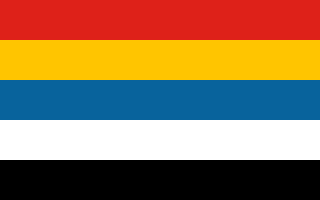
The Republic of China (ROC), between 1912 and 1949, was a sovereign state recognised as the official designation of China when it was based on Mainland China, prior to the relocation of its central government to Taiwan as a result of the Chinese Civil War. At a population of 541 million in 1949, it was the world's most populous country. Covering 11.4 million square kilometres, it consisted of 35 provinces, 1 special administrative region, 2 regions, 12 special municipalities, 14 leagues, and 4 special banners. The People's Republic of China (PRC), which rules mainland China today, considers ROC as a country that ceased to exist since 1949; thus, the history of ROC before 1949 is often referred to as Republican Era of China. The ROC, now based in Taiwan, today considers itself a continuation of the country, thus calling the period of its mainland governance as the Mainland Period of the Republic of China in Taiwan.

The Republic of China Armed Forces Reserve was a division of the Republic of China Armed Forces tasked with managing, planning, and mobilizing the reserve potential of Taiwan. It aimed to provide the first line of coastal defence and wartime operations through its reserve forces, and to sustain military mobilization to support ground operations, maintenance, and homeland security. Another major role of the Reserve Command was the recruitment, education, and training of effective reserve forces.















